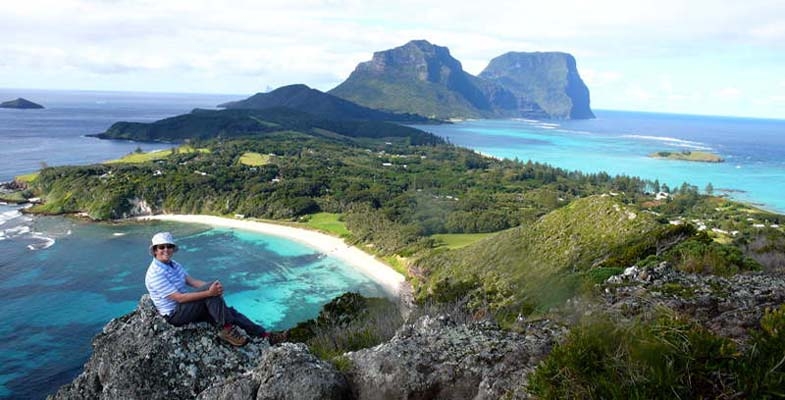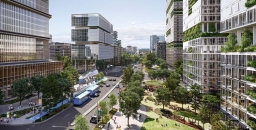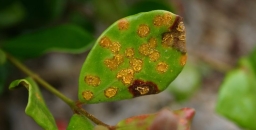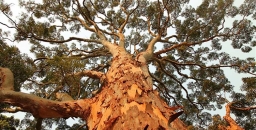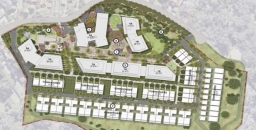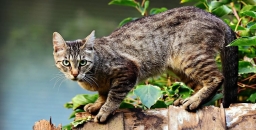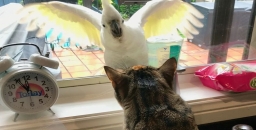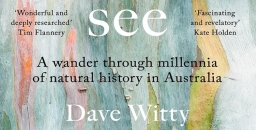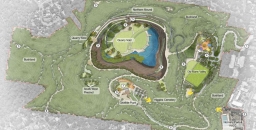Lord Howe Island is a magnificent island about 600 km off the coast of NSW. Its unique landform as an eroded volcanic peak and endemic biodiversity led to its classification as a World Heritage site. The southern end is dominated by the basalt peaks of Mt Gower (875 m) and Mt Lidgbird (777 m) covered in dense forests. The northern end is undulating and partially cleared for settlement. Lord Howe’s crescent shape embraces a sheltered lagoon and the southernmost coral reef on the planet.
The number of residents and visitors is limited by its small size and mountainous topography. Its economy depends on tourism and propagation and export of the kentia palm. The maximum number of tourists on the Island at any one time is constrained to 400 and the number of residents is about 350.
When I last visited the island in 2002 there was talk of a project to eradicate rodents. Rats and mice arrived in 1918 as escapees from a grounded ship. Rodents have contributed to the extinction of a number of species and are recognised as a threat to at least 13 bird species, 2 reptiles, 51 plant species, 12 vegetation communities and numerous threatened invertebrates.
The problem is that there is no native mammal species on the island that can compete with, or predate, on the rats and mice. Any impact on the natural values of the island diminishes tourism and recreation values since these are inextricably linked to the islands unique biodiversity and World Heritage values. (Attempts have been made to bring in other predators that are another example of the problems humans can cause when we interfere with nature – see the end of this article.)
Predation by rodents on kentia palm production reduces values associated with this commercial activity, via reduced production and added costs. In addition, rodents impose costs to residents and tourism operators via the need to bait to reduce visual presence of rodents, the spoiling of food stuffs and potentially health impacts to residents and tourists alike.
There has been a long process of investigation and consultation with concerned residents and I understand that the issues are still not resolved. The main problem is the acceptance of widespread use of poison baits. It is hoped that final approval will be granted later this year. The ABC Radio National Off Track program had two episodes on Lord Howe Island’s ecology during early June including discussion of the project and the damage being done by rats.
I recently discovered one of the reports on the project. The Economic Evaluation of the Lord Howe Island Rodent Eradication Project prepared by Gillespie Economics (November 2016). It is an interesting example of cost benefit analysis, the sort of analysis expected by government. As expected with an economic evaluation the report covers the financial aspects of the project. But it is also tries to quantify other community and environmental effects that cannot be directly related to money using some of the techniques of environmental economics.
Cost Benefit Analysis
Cost benefit analysis (CBA) provides a comparison of the additional costs and benefits with the rodent eradication project (REP), relative to without the REP. Provided the present value of additional benefits exceed the present value of additional costs, a project is considered to improve the wellbeing of society and hence is desirable from an economist’s point of view.
The net present value of a benefit or cost arising in the future takes into account the value of time through the process of discounting. The discount rate is a huge area of controversy. Business and government usually use commercial interest rates while society may consider a much lower rate is appropriate so that the interests of future generations are not discounted using the questionable theory that they will be better off than current generations.
A prime example is the issue of climate change – some argue that the costs borne in transitioning to renewable energy sources now do not justify the benefits of avoiding the loss of crops, bushfires, heat stress, sea level rise 50 or 100 years hence. If the benefits of avoiding costs in the long term are discounted at commonly used interest rates then the costs of transition today may exceed these benefits. Part of the problem is the broad assumptions needed to value loss of biodiversity and other environmental assets. The REP project analysis provides some examples of surrogate methods that are used. I will leave the reader to decide on the validity of the methods.
Scope of the REP
The Lord Howe Island Board currently implements a limited rodent control program at a cost of $85,000 per year. However, it is not reducing the rodent population sufficiently to limit landscape scale ecological impacts and there is a risk that continuation of the current approach will result in bait shyness and/or resistance in the rodent population.
The Lord Howe Island REP will use cereal baits laced with the anticoagulant Brodifacoum dispersed from helicopters in the uninhabited areas, and a combination of hand broadcasting, bait stations and bait trays in the settled area. Preparation is required to ensure some species are not killed by the baits. The iconic woodhens that were rescued from extinction and the local currarongs will have to be captured and caged for the period the baits are potent.
Without the REP, the current rodent control program would continue but this can only cover accessible areas of the island. The rodents have plenty of food sources all over the island. There would be continued presence of poison in the environment, continued impacts on the kentia palm and nursery industry, further degradation of World Heritage values (including endemic and threatened species) and the potential for Lord Howe Island to be inscribed on the List of World Heritage in Danger.
Cost Benefit Analysis Results
The analysis calculates that the present value of costs of the project and follow up management including measures to return species that are currently extinct from the island over 30 years is $9 million. By contrast the value of the benefits is $150 million. Hence this analysis shows that the economic value of the project is obvious.
Just looking at the cost of the project compared with ongoing costs of the current methods of control the net cost is about $8 million. Funding commitments have already been received from the NSW and Australian governments.
The removal of the effects of rodents on the kentia palm industry and vegetable production is valued at $1 million.
Some of the valuing of the benefits would be subject of much debate, for example:
- The improvement in biodiversity is deemed to increase visitor numbers. In warmer months when accommodation is already fully booked, increased demand is assumed to increase prices by 35%. In cooler months the accommodation demand is assumed to increase by 20% and prices by 7%. All this is assumed to have a present value over 30 years of $80 million.
- It is estimated that seven future extinctions will be avoided. The value of extinction prevention is based on several studies of community willingness to pay for the protection and recovery of threatened species. On an Australia-wide measure of community willingness to pay they are valued at $8 million each adjusted for a chance that the REP makes no difference to the chance of extinction to give a total of $40 million.
- There are also four species that are locally extinct, the Kermadec petrel, the white-bellied storm petrel, phasmid (stick insect) and wood-feeding cockroach. The return of these species is valued similarly with a deduction for the possibility of failure to reestablish the species at $27 million. One wonders if the general public would value the return of a species population by a transfer from another island in the same way as prevention of extinction of the only population of a species.
Even though some of these figures are debatable it is clear that the REP is worthwhile from an economic point of view. It is hoped that the local residents can be convinced of the benefits.
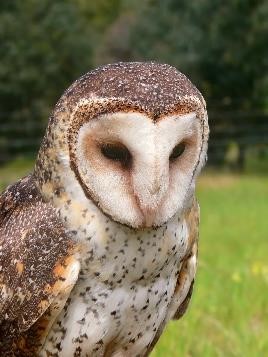 A Further Complication – the Masked Owl
A Further Complication – the Masked Owl
Not long after rats became a problem the authorities thought it was a good idea to introduce various owl species to control the rats. There is still a large population of Tasmanian Marked Owls. After the REP is completed their major food source will have disappeared so it is likely they will turn to other species. We don’t want more extinctions so a removal program will be required of these Masked Owls.

